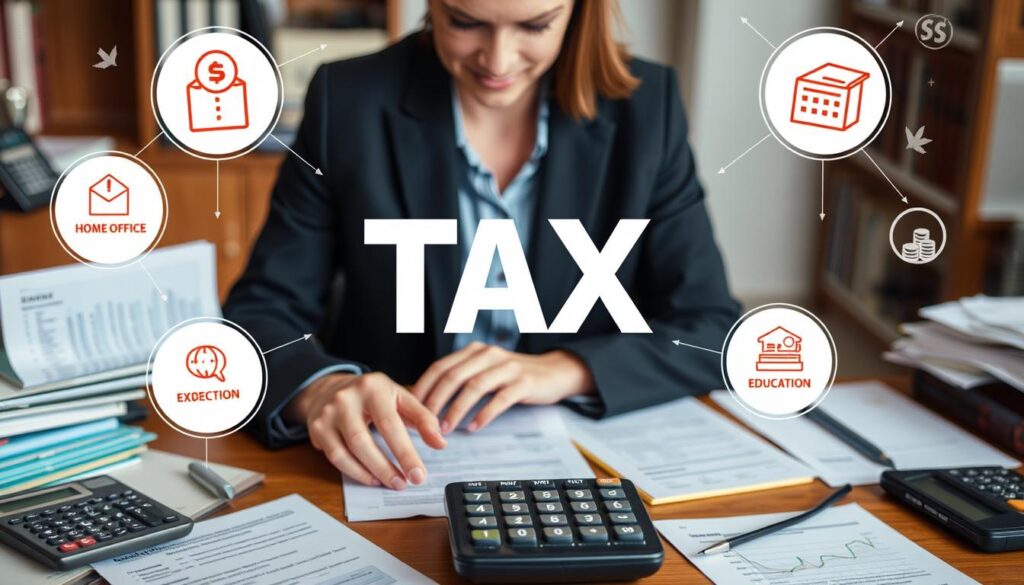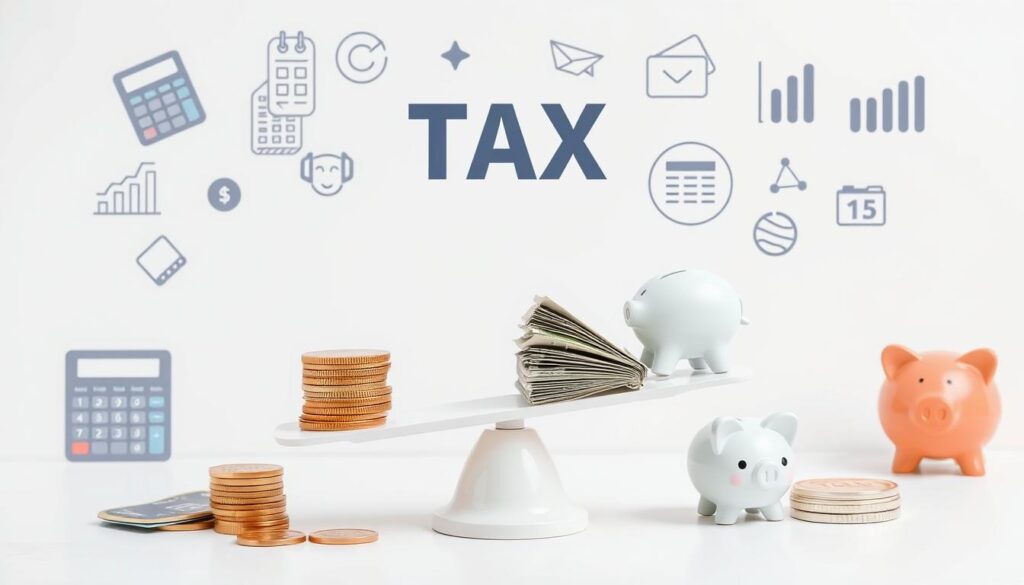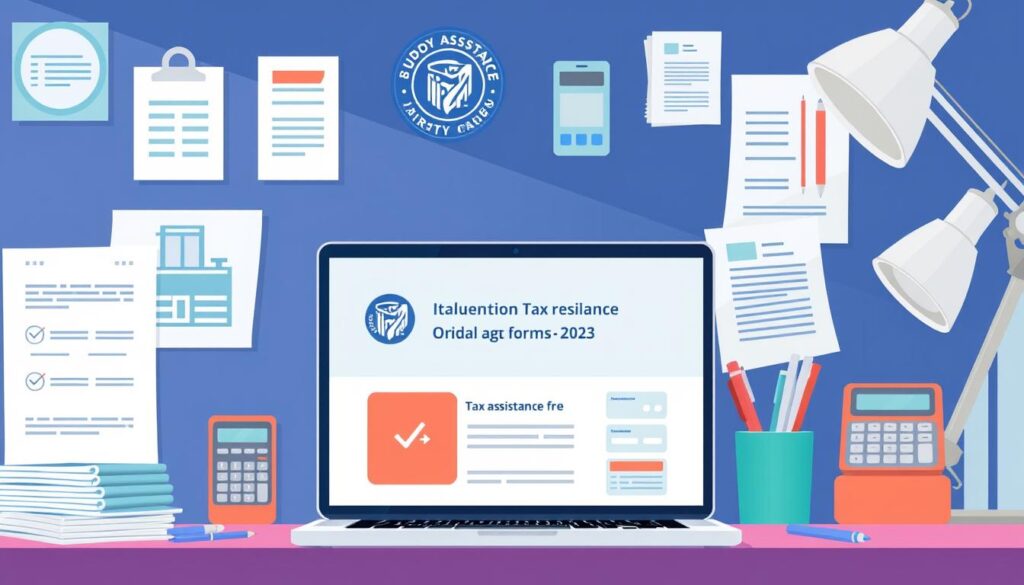You know that feeling you get in the pit of your stomach when tax season rolls around? The looming deadlines and stacks of paperwork can be overwhelming, but it doesn’t have to be that way. Easy tax filing can be achieved with the right tips and preparation. Imagine turning what has traditionally been a source of anxiety into a manageable task, navigating the labyrinth of tax forms with clarity and calm. With a few essential guidelines, you can create a stress-free environment that not only simplifies the process but also maximizes your potential deductions and credits. As you prepare to file your taxes, remember: you’re not alone in this. Many have walked this path, finding that taking it step-by-step can transform the experience from dreaded to doable. Let’s embark on this journey together, ensuring your tax return filing is smooth and manageable with these invaluable tax filing tips.
Recognizing the importance of being organized is vital, especially with the federal tax filing deadline looming on April 15th, a date that many dread but can easily meet with the right planning1. Most employers send out W-2 forms by the end of January, and if yours doesn’t arrive by the second week of February, it’s crucial to take action1. Feeling stressed? Incorporating healthy habits like exercise and meditation can significantly reduce the physical manifestations of stress, such as headaches and fatigue1. You don’t have to face this season in a panic; instead, with practical steps and an understanding of the basics, you can approach your tax return confidently.
Key Takeaways
- Understand your tax filing deadline to avoid penalties.
- Organize your paperwork early to ensure easy access to needed documents.
- Consider healthy habits to reduce stress during tax season.
- Utilize online tools for quick and efficient filing.
- Maximize your deductions and credits by staying informed on tax changes.
Understanding Tax Filing Basics
Before diving into the complexities of tax return filing, it’s essential to familiarize yourself with the tax filing basics. Understanding what to expect and interpreting common key terminology in taxes can significantly simplify the process. You should be aware that most of the federal government’s revenue comes from income taxes2. This context is crucial as you prepare to fill out your tax forms.
What You Need to Know Before Filing
Many factors influence your tax situation, including the type of income you have and the deductions for which you may qualify. In 2023, the IRS received approximately 162,037,000 individual income tax returns3. Filing taxes is mandatory even if you did not earn much money to ensure you don’t miss out on potential tax refunds2. Getting comfortable with tax forms like Form W-2 for employees and Form 1099 for self-employed workers can make filing your return much easier.
Key Terminology Defined
Grasping the key terminology in taxes is critical for smooth navigation through the tax filing system. For example, payroll taxes consist of a 6.2% Social Security tax and a 1.45% Medicare tax paid by employees3. Furthermore, the progressive nature of the income tax system in the U.S. means that higher-income individuals pay a larger percentage of their income compared to low-income individuals3. These concepts will surface frequently as you work through your forms.
Understanding Tax Forms
As you begin filing your taxes, knowing the various tax forms is essential. Each form serves its purpose: the W-2 form reports wages and taxes withheld, while the 1099-NEC is crucial for self-employed individuals2. For instance, employers match and pay the same payroll taxes, leading to a total of 12.4% for Social Security3. Understanding these forms will not just help you report income accurately, but also aid in comprehending deductions and credits available to you.

Choosing the Right Tax Filing Method
Deciding on the right method for tax filing can significantly influence your annual experience. You have choices ranging from DIY tax filing to enlisting the help of professional tax preparation services. Each option comes with its unique set of advantages and disadvantages.
DIY vs. Professional Help
While many taxpayers prefer DIY tax filing for its cost-effectiveness, professional tax preparation can provide peace of mind. Affordable options like IRS Free File allow those with an adjusted gross income of $79,000 or less to electronically file at no cost4. On the other hand, professionals can help navigate tax complexities and ensure compliance with current regulations.
Online Tax Software Options
When considering online tax software, options abound. TaxSlayer is recognized for affordability, while TurboTax Free Edition is suitable for approximately 37% of taxpayers who only need to file simple Form 1040 returns5. Companies like H&R Block offer in-person assistance through over 9,000 branches nationwide, catering to diverse filing preferences.
Benefits of E-filing
E-filing taxes provides several key benefits. Not only does it streamline the filing process, but it also enhances accuracy and security. Many taxpayers can expect quicker refunds; for instance, those using Cash App Taxes may receive their refunds five days quicker when deposited into a Cash App account5. Overall, e-filing offers a convenient and efficient method for managing your tax obligations.

Gathering Your Financial Documents
Preparing for tax season begins with collecting the necessary financial documents. To ensure a smooth filing process, it’s vital to gather key documents that prove your income and support your deductions. This includes standard income forms such as W-2s and 1099s, as well as receipts that validate any expenses you intend to claim.
Essential Documents You Should Collect
Start by compiling the following essential financial documents:
- Income documents: paycheck stubs, bank statements, and records of any digital asset transactions for accurate income reporting.
- Forms like W-2 and 1099-K for freelance and gig work, 1099-INT for interest, and 1099-DIV for dividends are crucial for reporting.
- Documents needed for credits and deductions: childcare expenses, mortgage statements, property tax records, and proof of charitable donations.
- For self-employed individuals, keep records of business income, expense receipts, and mileage logs.
Remember to hold on to these financial documents as they are essential for maximizing your chances of a successful return and audit compliance. The IRS suggests retaining significant documentation for up to three years following your return submission6.
How to Organize Your Paperwork
Organizing your paperwork in a systematic way can vastly improve your efficiency. Consider using labeled folders or a digital filing system to keep similar documents together. For instance, you might create separate folders for income statements, deduction records, and any correspondence with tax authorities. Using spreadsheets or financial software can help track and categorize your expenses, making it easier to locate necessary documents when filing.
Importance of Accuracy in Reporting
Achieving accuracy in tax reporting is paramount. Mistakes can lead to penalties or audits, which can be stressful and time-consuming. By consistently organizing your paperwork and ensuring you have all necessary financial documents at hand, you enhance your chances of filing a precise return. Additionally, validating your entries against the original documents will ensure a thorough and complete reporting process7.

Knowing Your Deadlines
Understanding your tax filing deadlines is vital to ensure you comply with federal deadlines and avoid penalties. For the 2025 tax year, the federal tax return deadline is April 15, 2025. Residents of Maine and Massachusetts have slightly extended deadlines, with returns due on April 17, 2025. If you have experienced recent disasters, such as Hurricane Helene or Hurricane Milton, you might qualify for an extension until May 1, 2025, to file your returns and make payments8. It’s essential to familiarize yourself with state tax requirements as well, as they usually align with federal deadlines but can differ in specific states.
Federal Tax Filing Deadlines
Calendar year filers must submit their federal individual income tax returns by April 15 each year9. Tax returns are considered timely if postmarked by this due date. If you serve in the armed forces in a combat zone, you receive at least 180 days post-deployment to file and pay9. For those needing an extension, a six-month tax extension can be requested, pushing the due date to October 1510.
State Tax Filing Requirements
Most states synchronize their income tax deadlines with federal deadlines. Notably, nine states, including Texas and Florida, do not impose a state income tax. However, specific taxpayers in states like Washington and New Hampshire face unique requirements10. Staying updated on your state’s individual tax rules and deadlines can help you avoid unnecessary complications.
Extensions and Their Implications
When you request a tax extension, you automatically receive an additional six months to file your return, making the deadline October 15, 2025. Keep in mind that extensions do not defer tax payments. If taxes owed are not paid by April 15, interest and penalties begin to accumulate10. Paying attention to estimated payment deadlines is crucial. Estimated payments for the first quarter are due on April 15, and subsequent payments are required throughout the year, with significant dates being June 16 and September 158.

Maximizing Deductions and Credits
When it comes to filing your taxes, understanding how to maximize deductions and credits can significantly enhance your savings. It’s essential to be aware of common deductions that many taxpayers overlook. Familiarizing yourself with these options will put you in a better position to take advantage of potential tax deductions.
Common Deductions You Might Overlook
Many individuals miss out on valuable deductions that can reduce their taxable income. Some of the most common, yet frequently overlooked, deductions include:
- Alimony payments;
- Contributions to an IRA or health savings account;
- Unreimbursed business expenses;
- Donations to charity;
- Home mortgage interest;
- Medical and dental expenses exceeding 7.5% of adjusted gross income.
The standard deduction amount for 2023 is $13,850 for single filers or those married filing separately, $27,700 for married couples filing jointly, and $20,800 for heads of household11. Knowing these figures can guide your strategic planning when preparing your tax returns.
Tax Credits That Can Save You Money
Tax credits provide direct reductions on the taxes you owe, making them more beneficial than deductions. Some popular tax credits to consider include:
- Childcare credit which provides up to $2,000 for families with children under 1712;
- Small business health insurance premium credit for eligible small business owners12;
- Work Opportunity Credit for hiring individuals facing barriers to employment12.
These credits can lead to significant savings, so it’s crucial to investigate any for which you may qualify.
Keeping Track of Potential Deductions
Maintaining organized records of all potential deductions ensures you won’t miss out on savings. Consider implementing a practice of keeping receipts and statements for your expenses throughout the year. Utilizing software like TurboTax can provide checklists of allowable deductions to avoid overlooking any deductions13. By adopting strategic practices such as bunching deductions, you can maximize their value, especially in areas with certain thresholds13.

Reviewing Your Tax Situation
Understanding your tax situation is essential for effective financial planning. The first step is conducting a thorough tax bracket assessment, which helps you gauge where your income stands and how much tax you should expect to pay. This evaluation considers various sources of income, such as wages, dividends, and IRA distributions, revealing your overall tax obligations and potential refunds.
Assessing Your Tax Bracket
To accurately assess your tax bracket, you need to understand that the federal marginal tax rate operates on a progressive system where higher income portions are taxed at increasing rates. This can significantly impact your tax liabilities. Financial advisors can assist you in comprehending how these marginal brackets affect your overall tax situation, ensuring you make informed financial decisions14.
Estimating How Much You Owe or Will Get Back
Estimating your tax liability isn’t just about knowing your bracket; it also means reviewing tax deductions and credits for which you may qualify. Factors like child tax credits, contributions to health savings accounts, and various deductions can reduce the amount you owe. Additionally, utilizing tools like the Interactive Tax Assistant can help clarify eligibility for credits you previously overlooked15.
Taxpayers should account for total payments, including federal tax withheld and estimated tax payments, to provide a clearer picture of their financial standing16.
Strategies for Tax Planning Ahead
Effective tax planning requires looking beyond the current fiscal year to identify opportunities for future savings. Strategies such as Roth conversions can provide long-term advantages, whereas tax-loss harvesting can help mitigate capital gains taxes. Collaborating with a financial advisor can enhance your tax planning efforts, helping you navigate complex tax situations and optimize your investment decisions for greater tax efficiency14.

Navigating Life Changes
Life changes, such as marriage or purchasing a home, can significantly influence your tax obligations. Additionally, income from side gigs necessitates careful reporting. Understanding these elements helps you manage your finances more effectively.
How Marriage Affects Your Tax Filing
Marriage can lead to beneficial tax filing impacts. For couples filing jointly in 2024, the standard deduction is $29,200, or $32,300 if both partners are over 6517. This can significantly reduce your taxable income. Couples may also qualify for credits like the Child Tax Credit, which is $2,000 per qualifying child under 17, with up to $1,700 potentially refundable17. Understanding these aspects can enhance your financial outcomes through effective planning.
Tax Implications of Home Buying
Buying a home comes with various tax implications that homeowners should know. Mortgage interest payments are typically deductible, which can save you quite a bit over time. Additionally, property taxes are usually reportable, and certain expenses related to buying a home might qualify for deductions, subject to individual circumstances. It’s important to stay updated on potential implications if you’re considering relocating, as state tax rates vary significantly, with some states imposing no income tax at all17.
Reportable Income from Side Gigs
Income from side gigs falls under specific categories of reportable income. Accurate side gig income reporting is crucial as it affects your overall tax return. Engage with a tax professional, especially if your side income becomes significant or if you operate a small business. Being proactive with this reporting can prevent issues down the line, making it easier to manage your tax responsibilities.

Dealing with Investment Income
Understanding your tax responsibilities related to investment income can save you from unnecessary headaches during tax season. Investments in stocks, bonds, and other assets come with specific regulations that pertain to investment income tax. It is crucial to grasp how different types of investments are taxed to prepare your tax return correctly.
Tax Responsibilities for Stocks and Bonds
When you sell stocks or bonds, your financial returns are subject to capital gains tax. The rate depends on how long you’ve held the asset. If you sell an asset held for over a year, any gains may be taxed at 0%, 15%, or 20%, whereas short-term gains are typically taxed at ordinary income rates ranging from 10% to 37%18. Additionally, if your modified adjusted gross income (MAGI) exceeds certain thresholds, you may face an extra 3.8% Net Investment Income Tax on investment income18.
Understanding Capital Gains Tax
Investors should be aware of the capital gains tax implications associated with their assets. Long-term capital gains generally enjoy reduced tax rates compared to short-term gains. For example, if you’ve held an asset for more than one year, your tax obligation could fall under the lower rates of 0%, 15%, or 20%19. It’s particularly important to understand that criteria for excluding capital gains on the sale of a primary residence can exempt gains up to $250,000 for singles or $500,000 for married couples, providing significant tax relief19.
Reporting Dividends and Interest Income
Another critical aspect of investment income tax involves reporting dividends. Qualified dividends are taxed at the same lower capital gains tax rates, but nonqualified dividends follow the standard ordinary income tax brackets. Properly classifying these dividends is essential for accurate reporting. Additionally, interest income must be fully reported, as it is typically taxed at ordinary income rates18.

Childcare and Education Tax Benefits
Understanding how to leverage childcare and education tax benefits can significantly alleviate your tax burden, especially if you are raising dependents. You may qualify for various credits and deductions designed to support families and enhance financial stability. Knowing the details about claiming dependents, education tax deductions, and childcare expenses can lead to substantial savings.
Claiming Dependents
When you are claiming dependents, it’s crucial to understand the potential tax credits available to you. Each qualifying dependent can substantially reduce your taxable income, which can increase your refund or decrease the taxes you owe. The Child and Dependent Care Credit allows individuals to claim 20% to 35% of their care expenses, with a maximum of $3,000 for one person or $6,000 for two or more people in tax year 202420. To qualify for this credit, individuals must provide the care provider’s name, address, and Tax Identification Number (TIN) on their tax return21.
Educational Credits and Deductions
Educational credits and deductions can significantly offset costs related to tuition and books. Utilizing education tax deductions can help reduce your taxable income, while education credits directly reduce the amount of tax owed. Keep in mind that different qualifications apply for various credits, so it’s wise to review which credits suit your situation best.
Tax Breaks for Childcare Expenses
Childcare expenses can be a substantial financial burden for families. Fortunately, the Child and Dependent Care Credit has provisions that have changed over the years, such as an increase in the eligible expense amount to $8,000 for one qualifying person and $16,000 for two or more qualifying individuals for tax year 202120. Furthermore, for 2021, the percentage of qualifying expenses eligible for the credit increased from 35% to 50%20. It is essential to accurately report your childcare expenses and consider that any dependent care benefits provided by your employer could affect the total dollar limit for claiming this credit21. Ensure to document all qualifying expenses accurately to maximize your tax savings.

Filing for Self-Employment
When you venture into the world of freelancing or self-employment, there are specific tax responsibilities that you must understand. These unique considerations help ensure you navigate self-employment taxes efficiently. Understanding the implications of tracking business expenses and managing quarterly estimated taxes is crucial for successful tax filing.
Unique Considerations for Freelancers
As a self-employed taxpayer, you are generally required to pay self-employment (SE) tax along with your income tax. If your net earnings exceed $400, you will need to file an income tax return, detailing your income and expenses. Self-employment tax is composed of Social Security and Medicare taxes, which collectively amount to 15.3% on your net earnings, and the calculations depend on your net profit after deducting allowable business expenses. For 2024, the Social Security portion is applied to the first $168,600 of your net earnings and rises to $176,100 in 202522.
Keeping Track of Business Expenses
Proper tracking of business expenses cannot be overstated when you are self-employed. Ordinary and necessary expenses related to your business can be deducted, lowering your taxable income. Common deductible expenses include business insurance, health insurance premiums, vehicle costs, and home office deductions for those who use part of their home for business2324.
It’s advisable to set aside 25-40% of your quarterly profit for estimated tax payments to avoid surprises at tax time24.
Quarterly Estimated Taxes Explained
You will need to make quarterly estimated tax payments if you expect to owe tax of $1,000 or more when you file your return. Due dates for these payments are staggered throughout the year, helping you manage your cash flow effectively. The payment schedule is as follows:
| Period | Due Date |
|---|---|
| January 1 to March 31 | April 15 |
| April 1 to May 31 | June 15 |
| June 1 to August 31 | September 15 |
| September 1 to December 31 | January 15 of the following year |
Being organized with your finances and understanding these tax obligations can pave the way for a smooth tax filing process for self-employed individuals.

Handling Errors on Your Tax Return
Mistakes can happen, and knowing how to address them is vital. Amending taxes not only corrects your tax return errors but also prevents potential penalties. To begin the process of amending your tax return, use Form 1040X for tax forms such as 1040 and 1040NR. Keep in mind that you need to file this form within three years after submitting your original return if you wish to claim a credit or refund25.
How to Amend Your Tax Return
When amending your tax return, you can electronically file for the years 2021, 2022, and 2023 using available tax software products, while amendments for other years must be submitted via paper26. Additionally, if you find yourself uncertain about your requirement to file a return, the IRS provides a helpful “Do I Need to File a Return” tool26.
Common Mistakes to Avoid
Common mistakes in filing can include misreporting income or failing to claim eligible deductions, which could lead to overpaid taxes. The IRS often identifies frequent errors made by taxpayers such as income omissions and math mistakes27. Notably, errors are acknowledged as common, emphasizing the importance of an efficient correction process27. If you believe the IRS filed a Substitute for Return on your behalf, an audit reconsideration process may be needed to make necessary corrections26.
The Importance of Double-Checking Your Work
Double-checking your work can save you both time and potential complications down the road. It’s crucial to review your tax returns for common errors like incorrect filing status and missed income reported on Form W-225. Be vigilant in ensuring that you are utilizing the correct forms and sending them to the appropriate IRS address for the specific tax year being filed. Remember, amended returns could take up to 20 weeks to process due to delays, so timely corrections are essential26.

What to Do If You Owe Taxes
If you find yourself in a situation where you owe taxes, it’s crucial to understand your options to manage this financial obligation effectively. Fear of tax penalties and the looming threat of interest can be overwhelming, yet there are structured approaches available to lessen the burden.
Exploring Payment Plan Options
The IRS offers various tax payment options to help you settle your debts. Individuals who owe less than $100,000 may qualify for a Short-Term Payment Plan, while those with total debts up to $50,000 can apply for a Long-Term Payment Plan. Initial setup fees for these plans vary, with a $31 fee for automatic withdrawals on debts over $25,000 and a $130 fee for smaller debts. Low-income taxpayers might even be eligible to waive these fees altogether28.
Understanding Penalties and Interest
It is important to be aware that the IRS imposes penalties for late filings. The failure-to-file penalty is set at 5% of the taxes due for every month or partial month a return is late, culminating in a maximum of 25% of total unpaid taxes. Furthermore, additional penalties and interest accrue on any unpaid taxes, and the IRS may escalate collection actions, potentially leading to liens or levies2928. Filing your tax returns—even if late—can help avoid these additional penalties because it prevents the IRS from filing a substitute return for you, which may result in a larger bill29.
Tax Relief Programs Available
If your tax bill is unmanageable, various tax relief programs can assist you. These include offers in compromise that allow you to settle tax debt for less than the total owed. The IRS provides options such as penalty abatement and payment plans tailored for those who genuinely cannot afford their tax obligations29. Approximately 25% of taxpayers who face significant tax burdens reach out for help through the Taxpayer Advocate Service30. Understanding these resources can significantly improve your financial situation.

Accessing Help and Resources
When tackling your taxes, accessing the right resources makes a significant difference. IRS resources can provide vital information that simplifies your tax filing process. Engaging with professional tax help can reduce errors and ensure compliance with the ever-changing tax laws. Additionally, community tax assistance is available to connect you with others facing similar challenges, offering valuable support and shared experiences.
IRS Resources You Should Know About
The IRS has developed a range of resources to assist taxpayers effectively. For instance, a significant percentage of taxpayers, around 70%, seek help when preparing their tax returns, indicating a strong preference for assistance over filing independently31. Among those who prepare their own returns, many can benefit from the IRS’s free e-filing options, particularly individuals with an adjusted gross income (AGI) limit of $79,000 or less, making free tax software accessible to many taxpayers32.
Seeking Professional Tax Assistance
Finding the right professional tax help can ease your filing experience. With approximately 150,000 paid tax return preparers listed in the Directory of Federal Tax Return Preparers, taxpayers have a wealth of options to choose from31. Also, nearly 60% of tax professionals have the authority to represent taxpayers before the IRS, adding a layer of security when disputes arise31.
Utilizing Online Community Forums
Onlining community forums can offer candid advice and support from fellow taxpayers who have navigated similar situations. Taxpayers can access forums that share experiences, tips, and tricks based on real-life scenarios. Many participants have found solace in discussing challenges, particularly during the busy tax season when the IRS received a record-breaking 282 million calls in 2021, which highlights the common quest for assistance32.

Preparing for Next Year
As another tax season comes to a close, it’s time to focus on future tax preparation. Establishing an organized system for record-keeping is crucial for simplifying your next tax return. By collecting and categorizing your financial documents now, you can save precious time and reduce stress in the upcoming year.
Keeping Records for Future Tax Returns
Maintaining detailed records is essential, especially if you engage in activities that generate non-wage income. Taxpayers with such income, including those earning from digital assets, should be aware that they may need to make additional tax payments. Moreover, staying proactive about your filing will ensure that you have everything needed for an accurate return ready at a moment’s notice33.
Setting Up a Tax Filing System
Implementing a tax filing system will make the process smoother come next tax season. You could opt for digital tools or apps that help keep things organized, especially if you utilize free brand name tax software, which is available to approximately 100 million taxpayers34. This structured approach not only enhances efficiency but also positions you well as updates on tax laws arise.
Staying Informed on Tax Law Changes
The importance of remaining updated on tax law changes cannot be overstated. By doing so, you’ll be equipped to adapt your filing strategies effectively. Remember that changes could affect deductions and credits, so staying informed will help ensure compliance and maximize your potential returns in the future33.
FAQ
What documents do I need for tax filing?
What are the benefits of e-filing taxes?
How do I know if I should do my taxes myself or hire a professional?
What is the standard tax filing deadline?
How can I maximize my deductions and credits?
What should I do if I make a mistake on my tax return?
Are there special tax considerations for self-employed individuals?
What tax relief options are available if I owe money?
How can I stay informed about tax law changes?
What resources can I access if I need help with my taxes?
Source Links
- https://www.eztaxreturn.com/blog/reduce-stress-this-tax-season-tips-for-easy-filing/ – Reduce Stress This Tax Season: Tips for Easy Filing
- https://files.consumerfinance.gov/f/documents/cfpb_building_block_activities_taxes-understanding-basics_handout.pdf – Taxes: Understanding the basics
- https://www.empower.com/the-currency/life/what-are-taxes – Tax 101: Understanding the basics
- https://www.irs.gov/filing/individuals/how-to-file – File your return | Internal Revenue Service
- https://www.cnbc.com/select/best-tax-software/ – The best tax software of 2025
- https://www.investopedia.com/articles/personal-finance/060315/tax-documents-you-should-always-keep.asp – Tax Documents You Should Always Keep
- https://www.irs.gov/filing/gather-your-documents – Gather your documents | Internal Revenue Service
- https://www.experian.com/blogs/ask-experian/tax-deadlines-you-need-to-know/ – 2025 Tax Deadlines You Need to Know – Experian
- https://www.irs.gov/taxtopics/tc301 – Topic no. 301, When, how and where to file
- https://www.nerdwallet.com/article/taxes/tax-deadline-tax-day-taxes-due – Tax Day 2025: Filing Due Date and Other Deadlines – NerdWallet
- https://www.irs.gov/credits-and-deductions-for-individuals – Credits and deductions for individuals
- https://1800accountant.com/blog/maximize-small-business-tax-deductions – 7 Tips to Maximize Deductions and Credits in 2024 | 1-800Accountant
- https://turbotax.intuit.com/tax-tips/tax-deductions-and-credits/how-to-maximize-your-itemized-tax-deductions/L1ANcotWP – How to Maximize Your Itemized Tax Deductions
- https://www.visionretirement.com/articles/why-a-financial-advisor-should-review-your-taxes – Five Reasons a Financial Advisor Should Review Your Tax Return — Vision Retirement
- https://www.irs.gov/individuals/get-ready-to-file-your-taxes – Get ready to file your taxes
- https://kindnessfp.com/review-your-tax-return/ – How to Review Your Tax Return – Common Tax Planning Mistakes – Kindness Financial Planning
- https://www.xoatax.com/life-events-taxes/ – Life Events and Taxes: A Comprehensive Guide to Navigating Tax Changes in 2024 – XOA TAX – Best CPA & Accounting Services – XOA TAX
- https://www.schwab.com/taxes/investment-related-taxes – Investment income taxes
- https://www.nerdwallet.com/article/taxes/investment-taxes-basics-investors – Taxes on Investments: The Basics to Know to Reduce Your Bill – NerdWallet
- https://turbotax.intuit.com/tax-tips/family/the-ins-and-outs-of-the-child-and-dependent-care-tax-credit/L2H7rzUWc – The Ins and Outs of the Child and Dependent Care Credit
- https://www.irs.gov/taxtopics/tc602 – Topic no. 602, Child and Dependent Care Credit
- https://www.businessinsider.com/personal-finance/taxes/how-to-pay-taxes-on-side-jobs-income-irs – Self-Employment Tax: Everything You Need to Know
- https://www.irs.gov/businesses/small-businesses-self-employed/self-employed-individuals-tax-center – Self-employed individuals tax center | Internal Revenue Service
- https://www.nextinsurance.com/blog/how-to-file-self-employment-taxes/ – How to file self-employment taxes: Calculate and pay step by step
- https://www.investopedia.com/articles/pf/09/inaccurate-tax-return.asp – You Filed an Inaccurate Tax Return. Now What?
- https://www.taxpayeradvocate.irs.gov/get-help/issues-errors/i-made-a-mistake-on-my-taxes/ – I Made a Mistake on My Taxes
- https://www.squire.com/resources/blog/made-mistake-tax-return-happens-now-2/ – Made a Mistake on Your Tax Return – What Happens Now?
- https://www.kiplinger.com/taxes/how-to-pay-the-irs-if-you-owe-taxes – How to Pay the IRS if You Owe Taxes
- https://www.nerdwallet.com/article/taxes/back-taxes-past-due-returns – Back Taxes: How to File Past-Due Returns – NerdWallet
- https://www.irs.gov/payments/get-help-with-tax-debt – Get help with tax debt
- https://www.irs.gov/newsroom/resources-to-help-you-prepare-your-tax-return-and-resolve-tax-disputes – Resources to Help You Prepare Your Tax Return and Resolve Tax Disputes
- https://www.investopedia.com/articles/tax/09/sources-free-tax-help.asp – 9 Sources for Free Tax Help
- https://www.irs.gov/newsroom/prepare-to-file-in-2025-get-ready-for-tax-season-with-key-updates-essential-tips – Prepare to file in 2025: Get Ready for tax season with key updates, essential tips
- https://www.consumerfinance.gov/consumer-tools/guide-to-filing-your-taxes/ – Guide to filing your taxes in 2024 | Consumer Financial Protection Bureau









